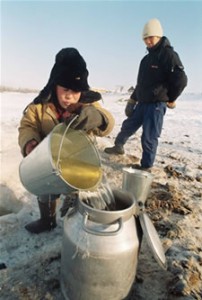Arctic Survival – Cooking, Food, and Water
Cooking and Food
When planning for cold weather cooking, it is essential to create a model of simplicity. Dexterity will be reduced because of thick gloves, motivation will be low because of a desire to crawl into the depths of your sleeping bag, and the cook may be very cold.
The best fuel to use is white gas. This burns fairly cleanly, and lights easily in cold temperatures. Kerosene is hard to light, gasoline is dirty, and compressed fuels such as butane or propane do not gasify in extreme cold. There are a variety of good lightweight backpacking stoves available that use white gas.
Due to the fact that much more heat is required to warm your food, and all water must be melted, plan to use at least four times as much fuel as you would in summer camping. Much fuel can be saved by using insulated pots (insulation on the sides and lid – not the bottom). It might be possible to secure some sort of flame retardant insulation to regular camping pots.
Carbon monoxide is released from the stove, so cooking should not take place in the tent. Ideally cooking should take place outside, but taking the realities of extreme Arctic conditions this is usually not possible. The best compromise is cooking in the vestibule of the tent, and making sure there is sufficient ventilation to carry out the fumes. Always be on your guard for carbon monoxide poisoning, and do not continue cooking if you are feeling drowsy. Never sleep while food is simmering on the stove.
Foods should require minimal preparation, and offer maximum caloric value. Freeze-dried meals are ideal. Be sure to carry additional fats such as butter and add liberally to the food. Treats such as chocolate, candies, dried fruits and nuts are good additions. Cut the chocolate into small pieces as it becomes rock hard in the cold.
Sugary teas and hot chocolate are pleasant treats and a good way to rehydrate and input energy. Arctic trekkers should carry at least 5000 calories of sustenance per person per day.
Chocolate, nuts and dried fruits convenient foods to eat throughout the day and are good for keeping up energy levels.
Water
Keeping hydrated is surprisingly complicated in the cold. Snow or ice must be melted and lengths must be taken to keep it from refreezing. In Siberia we fell into a routine of scooping mounds of snow into the vestibule (it takes a lot of snow to make a pot of water) before settling down for the night. This would then be melted on the stove after dinner and poured into thermoses. We each carried two one-litre stainless steel thermoses which would be enough to see us through the day. Water that wasn’t carried in thermoses would freeze in minutes in the -45 degree temperatures.

